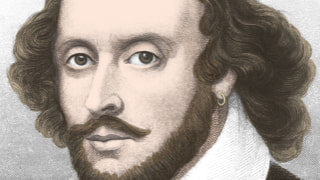The most influential writer in all of English literature, William Shakespeare was born in 1564 to a successful middle-class glove-maker in Stratford-upon-Avon, England. Shakespeare attended grammar school, but his formal education proceeded no further. In 1582 he married an older woman, Anne Hathaway, and had three children with her. Around 1590 he left his family behind and traveled to London to work as an actor and playwright. Public and critical acclaim quickly followed, and Shakespeare eventually became the most popular playwright in England and a part-owner of the Globe Theater. His career bridged the reigns of Elizabeth I (ruled 1558–1603) and James I (ruled 1603–1625), and he was a favorite of both monarchs. Indeed, James granted Shakespeare’s company the greatest possible compliment by bestowing upon its members the title of King’s Men. Wealthy and renowned, Shakespeare retired to Stratford and died in 1616 at the age of fifty-two. At the time of Shakespeare’s death, literary luminaries such as Ben Jonson hailed his works as timeless.
Shakespeare’s works were collected and printed in various editions in the century following his death, and by the early eighteenth century his reputation as the greatest poet ever to write in English was well established. The unprecedented admiration garnered by his works led to a fierce curiosity about Shakespeare’s life, but the dearth of biographical information has left many details of Shakespeare’s personal history shrouded in mystery. Some people have concluded from this fact and from Shakespeare’s modest education that Shakespeare’s plays were actually written by someone else—Francis Bacon and the Earl of Oxford are the two most popular candidates—but the support for this claim is overwhelmingly circumstantial, and the theory is not taken seriously by many scholars.
In the absence of credible evidence to the contrary, Shakespeare must be viewed as the author of the thirty-seven plays and 154 sonnets that bear his name. The legacy of this body of work is immense. A number of Shakespeare’s plays seem to have transcended even the category of brilliance, becoming so influential as to affect profoundly the course of Western literature and culture ever after.
The Tempest probably was written in 1610–1611, and was first performed at Court by the King’s Men in the fall of 1611. It was performed again in the winter of 1612–1613 during the festivities in celebration of the marriage of King James’s daughter Elizabeth. The Tempest is most likely the last play written entirely by Shakespeare, and it is remarkable for being one of only two plays by Shakespeare (the other being Love’s Labor’s Lost) whose plot is entirely original. The play does, however, draw on travel literature of its time—most notably the accounts of a tempest off the Bermudas that separated and nearly wrecked a fleet of colonial ships sailing from Plymouth to Virginia. The English colonial project seems to be on Shakespeare’s mind throughout The Tempest, as almost every character, from the lord Gonzalo to the drunk Stephano, ponders how he would rule the island on which the play is set if he were its king. Shakespeare seems also to have drawn on Montaigne’s essay “Of the Cannibals,” which was translated into English in
The extraordinary flexibility of Shakespeare’s stage is given particular prominence in The Tempest. Stages of the Elizabethan and Jacobean period were for the most part bare and simple. There was little on-stage scenery, and the possibilities for artificial lighting were limited. The King’s Men in
At the same time, The Tempest includes stage directions for a number of elaborate special effects. The many pageants and songs accompanied by ornately costumed figures or stage-magic—for example, the banquet in Act III, scene iii, or the wedding celebration for Ferdinand and Miranda in Act IV, scene i—give the play the feeling of a masque, a highly stylized form of dramatic, musical entertainment popular among the aristocracy of the sixteenth and seventeenth centuries. It is perhaps the tension between simple stage effects and very elaborate and surprising ones that gives the play its eerie and dreamlike quality, making it seem rich and complex even though it is one of Shakespeare’s shortest, most simply constructed plays.
It is tempting to think of The Tempest as Shakespeare’s farewell to the stage because of its theme of a great magician giving up his art. Indeed, we can interpret Prospero’s reference to the dissolution of “the great globe itself” (IV.i.
Read more about how Aldous Huxley drew from The Tempest in his novel, Brave New World.

Take a Quick Quiz on The Tempest and its author, William Shakespeare.

Dive into our comprehensive guide to ace your Shakespeare assignments













